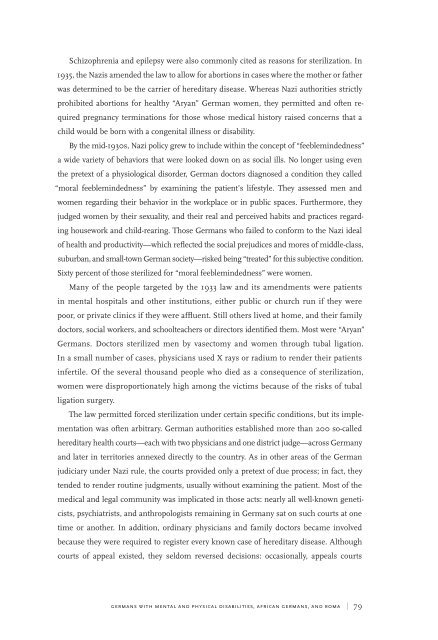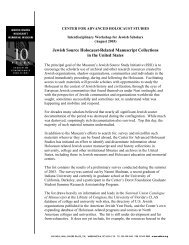the quest for racial purity - United States Holocaust Memorial Museum
the quest for racial purity - United States Holocaust Memorial Museum
the quest for racial purity - United States Holocaust Memorial Museum
You also want an ePaper? Increase the reach of your titles
YUMPU automatically turns print PDFs into web optimized ePapers that Google loves.
Schizophrenia and epilepsy were also commonly cited as reasons <strong>for</strong> sterilization. In<br />
1935, <strong>the</strong> Nazis amended <strong>the</strong> law to allow <strong>for</strong> abortions in cases where <strong>the</strong> mo<strong>the</strong>r or fa<strong>the</strong>r<br />
was determined to be <strong>the</strong> carrier of hereditary disease. Whereas Nazi authorities strictly<br />
prohibited abortions <strong>for</strong> healthy “Aryan” German women, <strong>the</strong>y permitted and often re-<br />
quired pregnancy terminations <strong>for</strong> those whose medical history raised concerns that a<br />
child would be born with a congenital illness or disability.<br />
By <strong>the</strong> mid-1930s, Nazi policy grew to include within <strong>the</strong> concept of “feeblemindedness”<br />
a wide variety of behaviors that were looked down on as social ills. No longer using even<br />
<strong>the</strong> pretext of a physiological disorder, German doctors diagnosed a condition <strong>the</strong>y called<br />
“moral feeblemindedness” by examining <strong>the</strong> patient’s lifestyle. They assessed men and<br />
women regarding <strong>the</strong>ir behavior in <strong>the</strong> workplace or in public spaces. Fur<strong>the</strong>rmore, <strong>the</strong>y<br />
judged women by <strong>the</strong>ir sexuality, and <strong>the</strong>ir real and perceived habits and practices regard-<br />
ing housework and child-rearing. Those Germans who failed to con<strong>for</strong>m to <strong>the</strong> Nazi ideal<br />
of health and productivity—which reflected <strong>the</strong> social prejudices and mores of middle-class,<br />
suburban, and small-town German society—risked being “treated” <strong>for</strong> this subjective condition.<br />
Sixty percent of those sterilized <strong>for</strong> “moral feeblemindedness” were women.<br />
Many of <strong>the</strong> people targeted by <strong>the</strong> 1933 law and its amendments were patients<br />
in mental hospitals and o<strong>the</strong>r institutions, ei<strong>the</strong>r public or church run if <strong>the</strong>y were<br />
poor, or private clinics if <strong>the</strong>y were affluent. Still o<strong>the</strong>rs lived at home, and <strong>the</strong>ir family<br />
doctors, social workers, and schoolteachers or directors identified <strong>the</strong>m. Most were “Aryan”<br />
Germans. Doctors sterilized men by vasectomy and women through tubal ligation.<br />
In a small number of cases, physicians used X rays or radium to render <strong>the</strong>ir patients<br />
infertile. Of <strong>the</strong> several thousand people who died as a consequence of sterilization,<br />
women were disproportionately high among <strong>the</strong> victims because of <strong>the</strong> risks of tubal<br />
ligation surgery.<br />
The law permitted <strong>for</strong>ced sterilization under certain specific conditions, but its imple-<br />
mentation was often arbitrary. German authorities established more than 200 so-called<br />
hereditary health courts—each with two physicians and one district judge—across Germany<br />
and later in territories annexed directly to <strong>the</strong> country. As in o<strong>the</strong>r areas of <strong>the</strong> German<br />
judiciary under Nazi rule, <strong>the</strong> courts provided only a pretext of due process; in fact, <strong>the</strong>y<br />
tended to render routine judgments, usually without examining <strong>the</strong> patient. Most of <strong>the</strong><br />
medical and legal community was implicated in those acts: nearly all well-known geneti-<br />
cists, psychiatrists, and anthropologists remaining in Germany sat on such courts at one<br />
time or ano<strong>the</strong>r. In addition, ordinary physicians and family doctors became involved<br />
because <strong>the</strong>y were required to register every known case of hereditary disease. Although<br />
courts of appeal existed, <strong>the</strong>y seldom reversed decisions: occasionally, appeals courts<br />
germans with mental and physical disabilities, african germans, and roma | 79
















